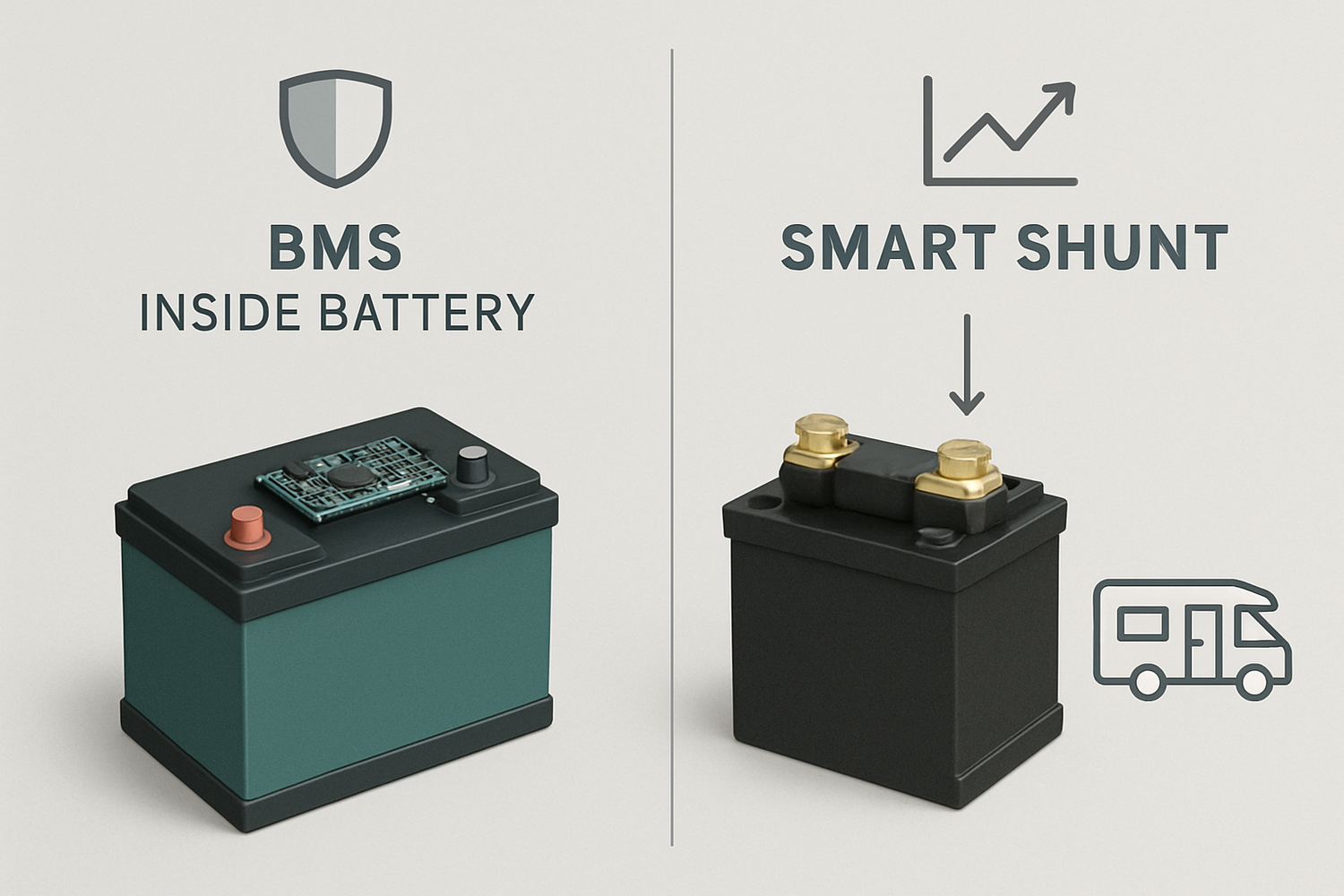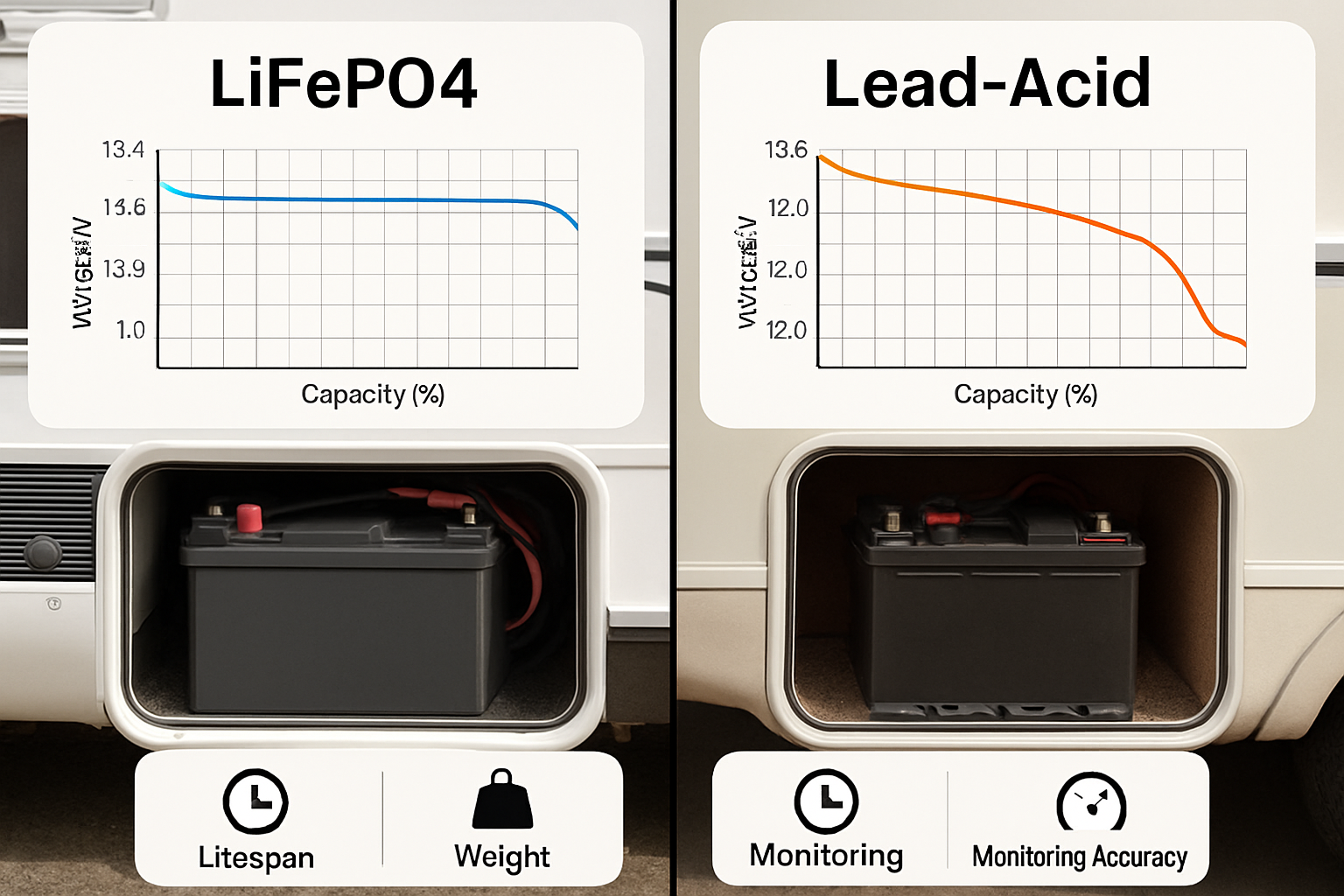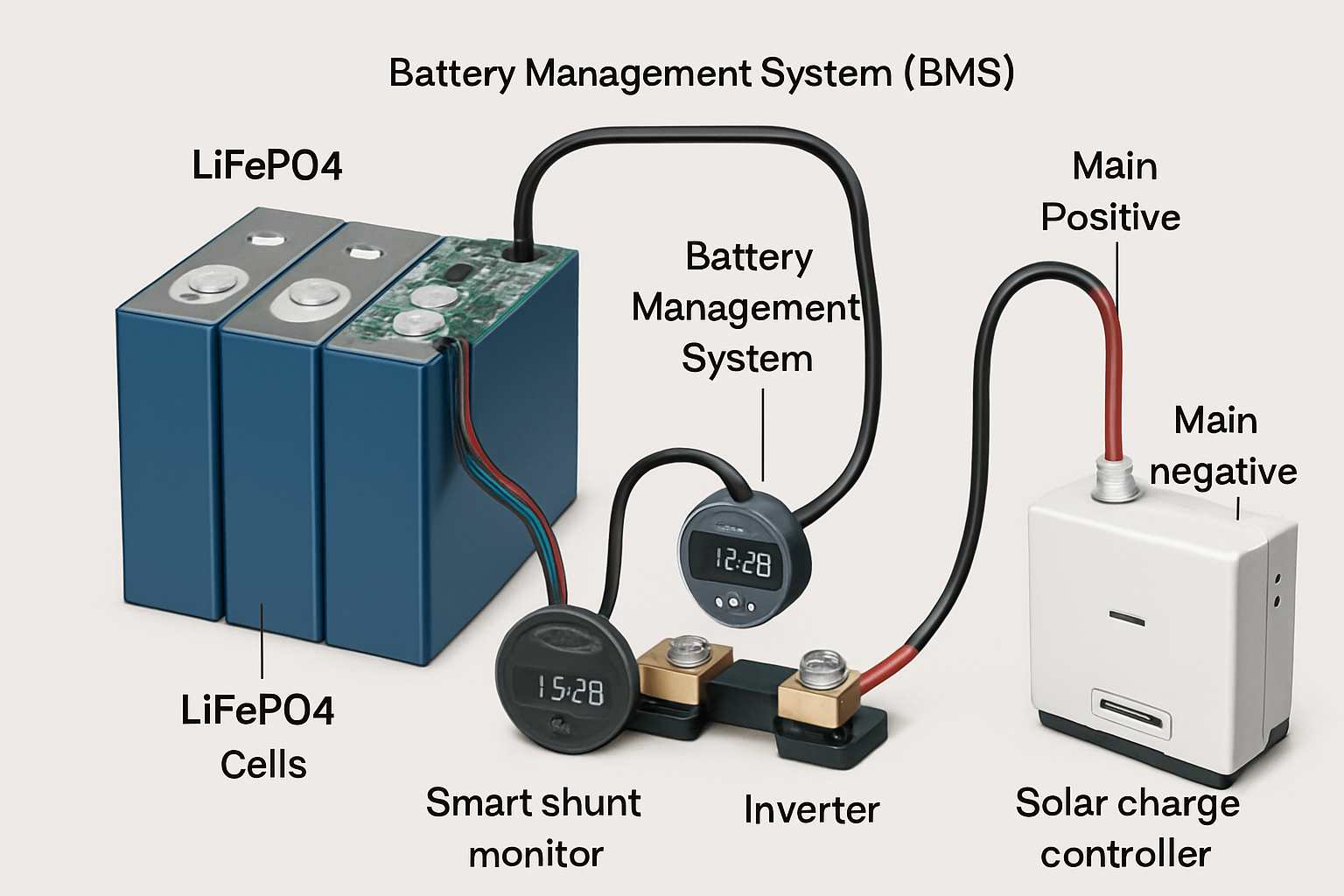Effective RV energy management is the foundation of a successful off-grid adventure. Knowing exactly how much power you have is critical for keeping the lights on, the refrigerator cold, and your devices charged. Two key components often discussed in this context are the Smart Shunt and the Battery Management System (BMS). While both are related to your battery, they serve fundamentally different purposes. Understanding this distinction is the first step toward building a reliable and efficient power system for your travels.
What is a Battery Management System (BMS)?
Think of a BMS as the dedicated guardian for your battery pack. It is an electronic system integrated directly into a lithium battery, such as a Lithium Iron Phosphate (LiFePO4) battery, to protect it from hazardous operating conditions. Its primary role is safety and longevity, not user-facing data analytics.
The Guardian of Your Battery
A quality BMS is non-negotiable for any lithium battery. It continuously monitors the battery's internal state to ensure it operates within safe limits. The core protective functions of a BMS include preventing over-charge, over-discharge, over-current, and extreme temperatures. It also performs cell balancing, a critical process that ensures all individual cells within the battery pack maintain an equal state of charge, which maximizes capacity and extends the battery's life. Without a BMS, a lithium battery is vulnerable to permanent damage and significant safety risks.
Monitoring Capabilities of a BMS
While a BMS does monitor key parameters like voltage, current, and temperature, its main job is to use this data to protect the battery. Some advanced BMS units provide an interface to access this data, but they are not primarily designed to be user-friendly 'fuel gauges'. The information can be less accurate for state-of-charge calculations than a dedicated device and may require specific hardware to interpret. The BMS is the silent protector working in the background.
What is a Smart Shunt?
If the BMS is the battery's guardian, the Smart Shunt is the precise, easy-to-read fuel gauge for your entire power system. It is an external device that you install in your RV to get a detailed, real-time picture of your energy usage and battery status.
The Fuel Gauge for Your Power System
A Smart Shunt is a highly accurate meter that measures the flow of current into and out of your battery bank. It works by using a principle called Coulomb counting, which precisely tracks every amp-hour that enters during charging and leaves during discharging. This method provides a far more accurate State of Charge (SoC) percentage than relying on voltage alone, which is notoriously unreliable for LiFePO4 batteries due to their flat discharge curve.
Data and Insights from a Smart Shunt
A Smart Shunt transforms guesswork into knowledge. It connects, often via Bluetooth, to a smartphone app, providing a wealth of actionable information. You can see real-time current draw, power consumption, remaining battery capacity, and even an estimate of 'time to go' at the current usage rate. This detailed monitoring is crucial for understanding how much power your appliances use—an average RV can consume 20-30 kWh per day, a figure that varies wildly with appliance use. This data empowers you to make informed decisions about your energy consumption.
Key Differences: A Head-to-Head Comparison
The core difference is simple: a BMS protects, and a Smart Shunt informs. They are not interchangeable; they perform distinct and complementary jobs within your RV energy system.
| Feature | Battery Management System (BMS) | Smart Shunt |
|---|---|---|
| Primary Function | Protection and safety | Monitoring and data reporting |
| Key Metrics | Cell voltage, temperature, internal current | State of Charge (SoC), real-time power, historical data |
| Data Accuracy (for SoC) | Variable; secondary function | Very high; primary function |
| Installation | Internal to the battery pack | External, on the negative battery cable |
| User Interface | Typically none or limited | Dedicated smartphone app or display |
Protection vs. Information
A BMS is like the airbag in your car—it's a critical safety system you hope you never need, but it must be there. It operates automatically to prevent catastrophic failure. A Smart Shunt is like your car's dashboard—it provides all the information you need for a smooth trip, like your fuel level (SoC), speed (current draw), and distance to empty (time to go).
Installation and Integration
Every reputable LiFePO4 battery comes with a BMS pre-installed; it is an integral part of the battery itself. A Smart Shunt, however, is an aftermarket component that you add to your system. It is installed in-line with the main negative cable that connects to your battery bank, allowing it to measure all power flowing through the system.
Do You Need Both a BMS and a Smart Shunt?
The short answer is yes. For a safe, reliable, and well-managed RV power system, you need both. They are not an 'either/or' choice.
Why a BMS is Non-Negotiable
For any lithium-ion battery, a BMS is an essential safety requirement. It safeguards your significant investment in your battery bank and ensures it operates safely for thousands of cycles. You should not use a lithium battery without an integrated BMS.
When to Add a Smart Shunt
You add a Smart Shunt when you want to move beyond basic power availability and actively manage your energy resources. If you want to know precisely how much power your coffee maker uses or how many hours of laptop use you have left, a Smart Shunt is the tool for the job. Real-time monitoring is vital for optimizing performance and extending the life of your energy storage system. Understanding these metrics is crucial for optimizing your system's performance. For a deeper look into key performance indicators for solar storage, the ultimate reference on solar storage performance provides valuable insights.
A Final Perspective on RV Energy Management
Achieving true energy independence on the road requires both safety and information. The BMS provides the fundamental safety net that makes modern lithium batteries a reliable power source. The Smart Shunt builds on that foundation, delivering the detailed data you need to manage your power consumption intelligently. Together, they form a complete RV battery monitoring and protection solution, empowering you to travel further and stay off-grid longer with confidence in your power system.
Frequently Asked Questions
Can a Smart Shunt replace a BMS?
No. A Smart Shunt is a monitoring device and offers no protective features. A BMS is essential for the safety and health of a lithium battery by preventing conditions like overcharge, over-discharge, and overheating.
Does every lithium battery come with a BMS?
High-quality, reputable lithium batteries designed for applications like RVs will always have an integrated BMS. It is a critical safety and performance component that is not considered optional.
How accurate is a Smart Shunt?
A properly calibrated Smart Shunt is highly accurate for calculating State of Charge, often to within a few percentage points. It uses Coulomb counting to track energy flow, which is far more reliable than monitoring voltage, especially for LiFePO4 batteries.
Is installing a Smart Shunt a difficult DIY project?
For individuals comfortable with basic 12V electrical work, installing a Smart Shunt is generally a straightforward process. It involves placing the shunt in line with the main negative battery cable and connecting a few small wires. Always follow the manufacturer's instructions carefully for a safe and correct installation.
Can I get detailed battery data from my BMS?
Some advanced BMS units feature communication ports that can output detailed data. However, accessing and interpreting this data often requires additional hardware, software, and technical knowledge. A Smart Shunt is designed to provide this information in a much more user-friendly format, typically through a dedicated display or a smartphone app.





Leave a comment
All comments are moderated before being published.
This site is protected by hCaptcha and the hCaptcha Privacy Policy and Terms of Service apply.